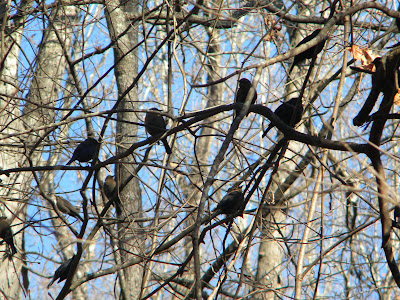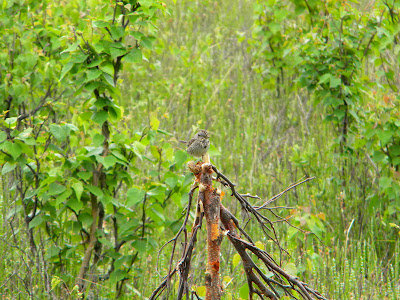
Yesterday morning my sister and I made the drive down to New Bern, NC to look for another very rare hummer for North Carolina--an Anna's. We had success seeing the Allen's 3 weeks ago before it left the area, so we decided we should try for only the 2nd or 3rd Anna's to visit NC. We headed out at 6:30 AM to make the 150 mile drive to New Bern. We found the home of Art and Joanne Behrer where the hummer has been regularly seen. They graciously allowed us to park in their driveway so we could stake out the feeders right in front of the house. Joanne told us she had seen the Anna's at 7:20 that morning.
We patiently looked and listened for the male Anna's to make an appearance. About 11 AM when it had not come in to feed, we decided to drive on down to the Morehead City area to do some other birding, expecting to stop back for the Anna's on our way home to Chapel Hill. We turned the car key to find we had a dead battery. AAA came to our rescue about 2 hours later, jumpstarting our car. In the mean time we kept looking for the Anna's, but it just was not around. At least we had a fly over bald eagle to brighten our day.
After stopping to buy a new battery we drove down to Fort Macon so my sis could at least get some time walking on the beach. While there we were able to see 3 purple sandpipers, one of which is in the photo above. There was also a sanderling hanging out on the small jetty end where the purple sandpipers were busily feeding. Not much else was happening at Fort Macon birdwise. We saw one common loon, a couple of double crested corms, and a few pelicans.

We made the 50 minute drive back to New Bern, arriving just about 4:30 to try again for the Anna's. The sun was setting and the feeders were totally in the shade. My sister has a very good ear, and she said she thought she heard the bird calling. We walked toward a row of bushes and sure enough we found it perched in a bush. Unfortunately, while the hummer was very cooperative in letting me take its picture, the light was not great so the photos just above and below are not much more than record shots (click on photo to enlarge). You can see a bit of red behind the eye in the bottom photo. Having seen the bird, our ride home was much more enjoyable.

Turning to the whirlwind end to John Vanderpoel's big year, he is on a plane as I type to Toronto, Canada. On Tuesday on their way to TN to try for the hooded crane, John and Doug Koch stopped long enough to have a fried chicken lunch with me at Mama Dip's in Chapel Hill. That evening they were planning on picking up Liz Southworth who was flying into Chattanooga from Boston. On Wednesday they did get good looks at the hooded crane which now has been seen at Hiwassee wildlife refuge in TN by hundreds of birders from around the US. They all made the 12 hour drive back to Hatteras on Wednesday. Yesterday about 1:30 they had a great skua fly over their boat--the target bird for the last minute pelagic trip run by Brian Patteson to help John in his quest for the full ABA area record.
John is on his way to Whitby Harbour which is about an hour east of Toronto in hopes of seeing a smew that was found there on Tuesday. Unfortunately it was not reported yesterday, but he is going to make the effort to find it before flying to Arizona this evening. He and his brother will be looking for the Nutting's flycatcher tomorrow--New Year's Eve day-- at Lake Havasu City to finish out his monumental big year. His YTD total stands as of yesterday at 743 including the hooded crane as a provisional awaiting TN bird records committee review as to its acceptability as a wild bird. Stay tuned!






















































